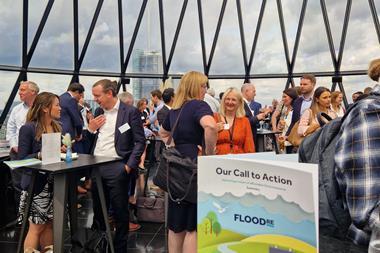Between 2000 and 2021, the number of global weather and climate disasters declined by around 10%, but what does this mean for insurers’ risk projections?
Mark Twain’s observation that “Facts are stubborn, but statistics are more pliable” will strike a chord with anyone investigating global warming.

According to the scientific community, it is a ‘fact’ that man-made carbon emissions produced since the industrial revolution are directly linked to recent alarming patterns of climate change.
Depending on the source, between 97% and over 99% of all peer-reviewed research has concluded this.
Dr. Paul Young, technical director and senior climate specialist at JBA Risk Management, said: “As stated in the latest Intergovernmental Panel on Climate Change report, grounded in the thorough assessment of extensive observational and theoretical evidence, it is unequivocal that human activity has warmed the climate.
“Given that the weather we experience is controlled by what the climate is, all weather is influenced by climate change.”
The area for debate concerns not whether climate change is affecting insurance losses – but by how much.
According to Swiss Re’s latest Sigma report, between 1992 and 2022 insured losses from natural catastrophes grew by 5% to 7% annually on average, but the main drivers of these increased losses were cited as urbanisation and rising populations in exposed areas, with factors such as social and economic inflation adding recent upward pressure.
The report stated: “Climate change effects likely play a role also, but are not a primary driver increasing losses, at least not yet.”
CREDible?
However, one theory doing the rounds is that current climate change thinking is contradicted by data from the Emergency Events Database (EM-DAT), maintained by the Centre for Research on the Epidemiology of Disasters (Cred).
This could have serious implications for the assumptions made by our insurance industry. So, Insurance Times investigated.
Read: What does an effective response to the threat of systemic risks look like?
Read: The Big Question May 2023 – What emerging risks should insurance firms watch out for in 2023?
Explore more sustainability-related content here or discover other news analysis content here
Cred, a department at the University of Louvain in Belgium, is an independent scientific body, and its EM-DAT is used by international and national institutions for risk management data purposes. So, it has considerable credibility.
The key headline figure in question is its finding that, between 2000 and 2021, the number of global weather and climate disasters declined by around 10%.
However, the scientific community stresses that it is highly wary of talking in terms of numbers of events, which is an area synonymous with data uncertainties.
One problem is that like is not always being compared with like. There could, for example, be a threshold like a monetary sum or a number of fatalities that has to be met for something to be declared an event.
Steve Bowen, chief science officer at Gallagher Re, said: “From a scientific standpoint it gets a bit murky around frequency of events occurring. We aren’t really seeing an increase in the number of events, but what’s changing is that events, when they do occur, are becoming more intense and impactful.”
Paul Walsh, chief executive of Meteomatics North America, agreed, pointing to a marked rise in billion-dollar events in the US. Between 1980 and 2022, there was an average of 7.9 of these a year, but in the last five years the annual average has risen to 17.8.
He said: “It’s a very tangled web when we talk about frequency of events as opposed to impact, which is a clearer and more objective way of measuring it.”
More significantly still, even Cred itself does not believe that its findings contradict the commonly held climate change stance.
Damien Delforge, senior researcher at Cred, said: “I believe man made CO2 emissions are responsible for global warming and the number of events is not considered a good indicator of the effect of climate change. 10% is also not a significant decrease, bearing in mind the potential for errors from different methods of statistical reporting.”
Indeed, Delforge can’t actually rule out a percentage increase over the period because he acknowledges the true picture could be distorted by advances in reporting and by different definitions of disaster.
“In Southeast Asia, the monsoon season can be considered a single disaster in some years, but several different disasters in other years,” Delforge continued. “And disasters could be significantly under-reported in Africa, where data tends to be less accurate.
“It’s better to look at meteorological change, as the number of natural hazards worldwide is increasing hugely, but there are a lot of risk management methods that can stop these developing into disasters.”
Just a historical pattern?
Another commonly presented argument by climate change sceptics is that the world has experienced fluctuations in temperature over many centuries and that we are currently just seeing a continuation of this.
But the scientific community is united in stressing that the spike in warming that has resulted from man-made carbon emissions is on a completely different scale to what has come before.
Patrick Sheehan, founder and managing partner at ETF Partners, said: “We can see what’s happened over hundreds of years and there’s no doubt this is different. The modern variation is much sharper.
“I’m not aware of a reputable scientist during the last decade disputing the link between man-made emissions and global warming unless they have been associated with the oil and gas industries.”
According to scientists at NASA’s Goddard Institute for Space Studies (GISS), the average global temperature has risen by at least 1.1 degree celsius since 1880, with the majority of the warming occurring since 1975 – at a rate of around 0.15 to 0.20 degrees Celsius per decade since then.
If this doesn’t sound very frightening, for context, it only took a between one and two degree drop to trigger the Little Ice Age!
Spotlight
If climate change sceptics can be attributed with any sort of positive, it is that they safeguard against insurer complacency by keeping the subject in the limelight.
Heikki Vesanto, manager of GIS data science at LexisNexis Risk Solutions, said: “It’s still important to keep the discussion about the link with climate change going to emphasise the need for insurers to make sure they are preparing for what is to come. By 2050, for example, the areas in the UK impacted by subsidence will double.”
But constantly having to dispute pliable statistics that challenge scientific fact is also wasting energy that could be better deployed elsewhere.
Phillip Martin, director of GeoSmart Information, said: “We know some major organisations are struggling to find affordable insurance cover and, instead of arguing about climate change, we need to focus on how to be resilient to it.
“Insurers need to further increase their involvement with building better infrastructure to combat the effects of climate change. We need better water management facilities to cope with drought and excess rain.”
It certainly seems strange that it’s possible to have flood warnings and hosepipe bans running concurrently in the same area. Solving that type of conundrum should perhaps be a higher priority than arguing with climate change deniers.












































No comments yet